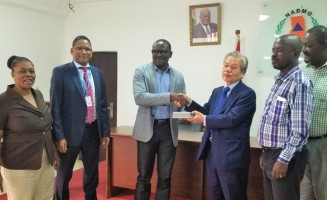 Early warning systems are a major component of disaster risk reduction. They prevent loss of life, as well as reducing the economic impact of natural hazards. Increasing the availability of multi-hazard early warning systems and disaster risk information is one of seven global targets set by The Sendai Framework for Disaster Risk Reduction 2015-2030.
Early warning systems are a major component of disaster risk reduction. They prevent loss of life, as well as reducing the economic impact of natural hazards. Increasing the availability of multi-hazard early warning systems and disaster risk information is one of seven global targets set by The Sendai Framework for Disaster Risk Reduction 2015-2030.
UNESCO promotes scientific exchange and collaborative efforts in order to establish effective early warning systems for different hazards such as tsunamis, landslides, volcanoes, earthquakes, floods and droughts. UNESCO helps Member States to collectively achieve effective early warning and monitoring, aids coordination between existing research centres, and educates communities at risk about preparedness measures, including setting up warning and emergency response Standard Operating Procedures and community drill exercises. UNESCO promotes community-based approaches in the development of response plans and awareness campaigns, which strongly involve educational institutions and end-users. Furthermore, UNESCO is a member of the International Multi-Hazard Early Warning Systems (MHEWS) network.
UNESCO's Contribution

The Intergouvernemental Oceanographic Commission
The overall objective of the project is to provide reliable climate services to monitor and forecast droughts and floods at the local level to improve national risk management strategies and to lower the impact of water-related hazards on vulnerable communities through improved communication and outreach in pilot regions of Latin America, the Caribbean and Africa, with particular attention to climate change vulnerabilities.

Intergovernmental Hydrological Programme (IHP)
is the only intergovernmental programme of the United Nations system devoted to water research and management, and related education and capacity development. They also work on water related disasters.

International Platform on Earthquake Early Warning Systems (IP-EEWS)
Launched in 2015 by UNESCO, this initiative aims to promote the development of Earthquake Early Warning for earthquake-prone regions in the overarching effort to strengthen communities’ preparedness and resilience against natural hazards.
UNESCO's Partners

The creation of the International Network for Multi-Hazard Early Warning Systems (IN-MHEWS) was announced at the Third United Nations (UN) World Conference for Disaster Risk Reduction (WCDRR) in Sendai, Japan in March 2015. This multi-stakeholder partnership was subsequently launched in February 2016 to facilitate the sharing of expertise and good practice for MHEWS as a national strategy for DRR, climate change adaptation, and building resilience. WMO and UNOOSA and UN-SPIDER co-chair the platform. UNESCO is a strong contributor from various early warnings such as tsunami, flood and earthquake.

International Institue of Earthquake Engineering and Seismology (IIEES)
The IIEES Is a Category 2 Research center specialized in earthquake engineering and seismology based in Iran.



